主要内容
- Spring Security 模块
- 使用
- 设置用户名密码
- 基于内存
- 基于UserDetailsService 接口
- 基于配置类WebSecurityConfigurerAdapter
- 基于DB 用户-角色-权限
- 自定义登录页面
- 登录认证流程
- 自定义成功、自定义失败
- 会话管理(Session)
- 会话控制
- 会话超时
- 会话并发控制
- 集群session
- 安全会话cookie
- RememberMe
- 退出登录
- CSRF
- 原理
- 用户授权(访问控制)
- web授权: url拦截进行授权 FilterSecurityInterceptor
- 访问控制的url匹配
- RequestMatcher接口
- 内置的访问控制
- 自定义403处理方案
- 基于表达式的访问控制
- 自定义方法 ExceptionTranslationFilter
- 方法授权: 方法拦截进行授权 MethodSecurityInterceptor
- JSR-250注解
- @Secured注解
- 支持表达式的注解
- 授权原理
- 授权流程
- Spring Security实现原理 @EnableWebSecurity
- 主线源码分析
Spring Security 模块
- 核心模块 - spring-security-core.jar:包含核心验证和访问控制类和接口,远程支持的基本配置API,是基本模块
- 远程调用 - spring-security-remoting.jar:提供与 Spring Remoting 集成
- 网页 - spring-security-web.jar:包括网站安全的模块,提供网站认证服务和基于URL访问控制
- 配置 - spring-security-config.jar:包含安全命令空间解析代码,若使用XML进行配置则需要
- LDAP - spring-security-ldap.jar:LDAP 验证和配置,若需要LDAP验证和管理LDAP用户实体
- ACL访问控制表 - spring-security-acl.jar:ACL(Access Control List)专门领域对象的实现
- CAS - spring-security-cas.jar:CAS(Central Authentication Service)* 客户端继承,若想用CAS的SSO服务器网页验证
- OpenID - spring-security-openid.jar:OpenID网页验证支持
- Test - spring-security-test.jar:支持Spring Security的测试
使用
<!-- 实现对 Spring MVC 的自动化配置 -->
<dependency>
<groupId>org.springframework.boot</groupId>
<artifactId>spring-boot-starter-web</artifactId>
</dependency>
<!-- 实现对 Spring Security 的自动化配置 -->
<dependency>
<groupId>org.springframework.boot</groupId>
<artifactId>spring-boot-starter-security</artifactId>
</dependency>
@RestController
@RequestMapping("/admin")
public class AdminController {
@RequestMapping("/demo")
public String demo() {
return "spring security demo";
}
}

http://localhost:8080/admin/demo
login DefaultLoginPageGeneratingFilter
需要登录,默认用户名:user,密码可以查看控制台日志获取
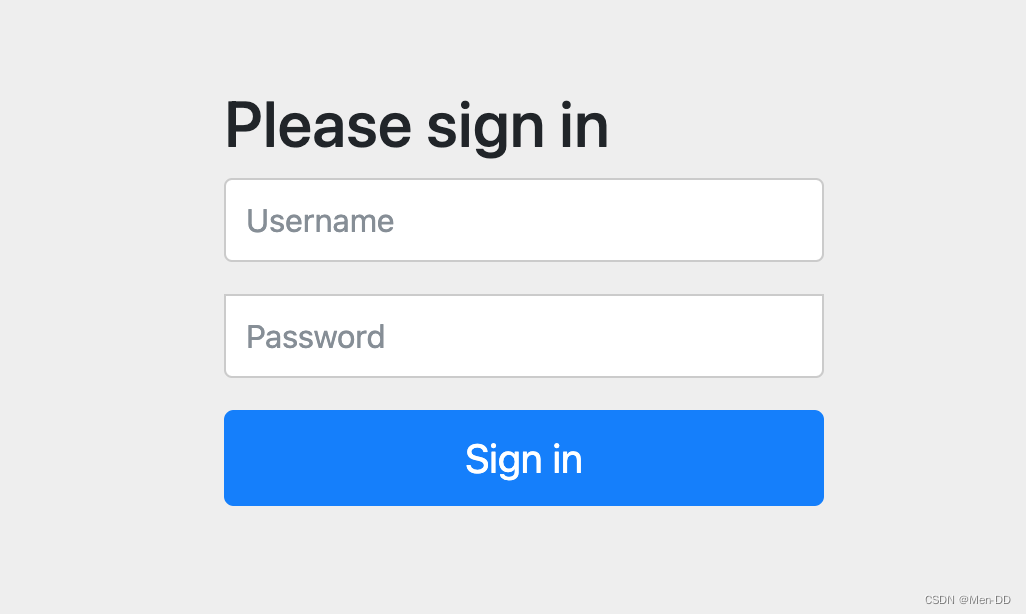
设置用户名密码
UserDetailsServiceAutoConfiguration -> UserDetailsService
public interface UserDetailsService {
UserDetails loadUserByUsername(String username) throws UsernameNotFoundException;
}
- 基于内存
spring:
security:
user:
name: mendd
password: 123456
- 基于UserDetailsService 接口
@Service
public class UserDetailsServiceImpl implements UserDetailsService {
@Override
public UserDetails loadUserByUsername(String username) throws UsernameNotFoundException {
return new org.springframework.security.core.userdetails.User("mendd", "123456", AuthorityUtils.commaSeparatedStringToAuthorityList("admin, user"));
}
}

PasswordEncoderFactories
public class PasswordEncoderFactories {
public static PasswordEncoder createDelegatingPasswordEncoder() {
String encodingId = "bcrypt";
Map<String, PasswordEncoder> encoders = new HashMap<>();
encoders.put(encodingId, new BCryptPasswordEncoder());
encoders.put("ldap", new org.springframework.security.crypto.password.LdapShaPasswordEncoder());
encoders.put("MD4", new org.springframework.security.crypto.password.Md4PasswordEncoder());
encoders.put("MD5", new org.springframework.security.crypto.password.MessageDigestPasswordEncoder("MD5"));
encoders.put("noop", org.springframework.security.crypto.password.NoOpPasswordEncoder.getInstance());
encoders.put("pbkdf2", new Pbkdf2PasswordEncoder());
encoders.put("scrypt", new SCryptPasswordEncoder());
encoders.put("SHA-1", new org.springframework.security.crypto.password.MessageDigestPasswordEncoder("SHA-1"));
encoders.put("SHA-256", new org.springframework.security.crypto.password.MessageDigestPasswordEncoder("SHA-256"));
encoders.put("sha256", new org.springframework.security.crypto.password.StandardPasswordEncoder());
encoders.put("argon2", new Argon2PasswordEncoder());
return new DelegatingPasswordEncoder(encodingId, encoders);
}
}
指定加密方式 spring security官方推荐的加密方式BCrypt
@Configuration
public class WebSecurityConfig {
@Bean
public PasswordEncoder passwordEncoder() {
// return NoOpPasswordEncoder.getInstance();
return new BCryptPasswordEncoder();
}
}
UserDetailsService
@Service
public class MyUserDetailsService implements UserDetailsService {
@Autowired
private PasswordEncoder passwordEncoder;
@Override
public UserDetails loadUserByUsername(String username) throws UsernameNotFoundException {
//自定义逻辑封装
String password = passwordEncoder.encode("123456");
// return new org.springframework.security.core.userdetails.User("mendd", password, AuthorityUtils.commaSeparatedStringToAuthorityList("admin, user"));
return User.withUsername("mendd").password(password).authorities("admin","user").build();
}
}
- 基于配置类WebSecurityConfigurerAdapter
@Configuration
public class WebSecurityConfig extends WebSecurityConfigurerAdapter{
@Autowired
private MyUserDetailsService myUserDetailsService;
@Override
protected void configure(AuthenticationManagerBuilder auth) throws Exception {
// auth.userDetailsService(myUserDetailsService);
auth.inMemoryAuthentication()
.withUser("mendd1")
.password(passwordEncoder().encode("123456"))
.authorities("admin");
}
}
- DB 用户-角色-权限
DB
CREATE TABLE `tb_user` (
`id` bigint(20) NOT NULL AUTO_INCREMENT,
`username` varchar(50) NOT NULL COMMENT '用户名',
`password` varchar(64) NOT NULL COMMENT '密码,加密存储',
`phone` varchar(20) DEFAULT NULL COMMENT '注册手机号',
`email` varchar(50) DEFAULT NULL COMMENT '注册邮箱',
`created` datetime NOT NULL,
`updated` datetime NOT NULL,
PRIMARY KEY (`id`),
UNIQUE KEY `username` (`username`) USING BTREE,
UNIQUE KEY `phone` (`phone`) USING BTREE,
UNIQUE KEY `email` (`email`) USING BTREE
) ENGINE=InnoDB AUTO_INCREMENT=38 DEFAULT CHARSET=utf8 COMMENT='用户表';
insert into `tb_user`(`id`,`username`,`password`,`phone`,`email`,`created`,`updated`) values
(37,'mendd','$2a$10$9ZhDOBp.sRKat4l14ygu/.LscxrMUcDAfeVOEPiYwbcRkoB09gCmi','158xxxxxxx','[email protected]','2019-04-04 23:21:27','2019-04-04 23:21:29');
CREATE TABLE `tb_role` (
`id` bigint(20) NOT NULL AUTO_INCREMENT,
`parent_id` bigint(20) DEFAULT NULL COMMENT '父角色',
`name` varchar(64) NOT NULL COMMENT '角色名称',
`enname` varchar(64) NOT NULL COMMENT '角色英文名称',
`description` varchar(200) DEFAULT NULL COMMENT '备注',
`created` datetime NOT NULL,
`updated` datetime NOT NULL,
PRIMARY KEY (`id`)
) ENGINE=InnoDB AUTO_INCREMENT=38 DEFAULT CHARSET=utf8 COMMENT='角色表';
insert into `tb_role`(`id`,`parent_id`,`name`,`enname`,`description`,`created`,`updated`) values
(37,0,'超级管理员','mendd',NULL,'2019-04-04 23:22:03','2019-04-04 23:22:05');
CREATE TABLE `tb_user_role` (
`id` bigint(20) NOT NULL AUTO_INCREMENT,
`user_id` bigint(20) NOT NULL COMMENT '用户 ID',
`role_id` bigint(20) NOT NULL COMMENT '角色 ID',
PRIMARY KEY (`id`)
) ENGINE=InnoDB AUTO_INCREMENT=38 DEFAULT CHARSET=utf8 COMMENT='用户角色表';
insert into `tb_user_role`(`id`,`user_id`,`role_id`) values
(37,37,37);
CREATE TABLE `tb_permission` (
`id` bigint(20) NOT NULL AUTO_INCREMENT,
`parent_id` bigint(20) DEFAULT NULL COMMENT '父权限',
`name` varchar(64) NOT NULL COMMENT '权限名称',
`enname` varchar(64) NOT NULL COMMENT '权限英文名称',
`url` varchar(255) NOT NULL COMMENT '授权路径',
`description` varchar(200) DEFAULT NULL COMMENT '备注',
`created` datetime NOT NULL,
`updated` datetime NOT NULL,
PRIMARY KEY (`id`)
) ENGINE=InnoDB AUTO_INCREMENT=44 DEFAULT CHARSET=utf8 COMMENT='权限表';
insert into `tb_permission`(`id`,`parent_id`,`name`,`enname`,`url`,`description`,`created`,`updated`) values
(37,0,'系统管理','System','/',NULL,'2019-04-04 23:22:54','2019-04-04 23:22:56'),
(38,37,'用户管理','SystemUser','/users/',NULL,'2019-04-04 23:25:31','2019-04-04 23:25:33'),
(39,38,'查看用户','SystemUserView','',NULL,'2019-04-04 15:30:30','2019-04-04 15:30:43'),
(40,38,'新增用户','SystemUserInsert','',NULL,'2019-04-04 15:30:31','2019-04-04 15:30:44'),
(41,38,'编辑用户','SystemUserUpdate','',NULL,'2019-04-04 15:30:32','2019-04-04 15:30:45'),
(42,38,'删除用户','SystemUserDelete','',NULL,'2019-04-04 15:30:48','2019-04-04 15:30:45'),
(44,37,'内容管理','SystemContent','/contents/',NULL,'2019-04-06 18:23:58','2019-04-06 18:24:00'),
(45,44,'查看内容','SystemContentView','/contents/view/**',NULL,'2019-04-06 23:49:39','2019-04-06 23:49:41'),
(46,44,'新增内容','SystemContentInsert','/contents/insert/**',NULL,'2019-04-06 23:51:00','2019-04-06 23:51:02'),
(47,44,'编辑内容','SystemContentUpdate','/contents/update/**',NULL,'2019-04-06 23:51:04','2019-04-06 23:51:06'),
(48,44,'删除内容','SystemContentDelete','/contents/delete/**',NULL,'2019-04-06 23:51:08','2019-04-06 23:51:10');
CREATE TABLE `tb_role_permission` (
`id` bigint(20) NOT NULL AUTO_INCREMENT,
`role_id` bigint(20) NOT NULL COMMENT '角色 ID',
`permission_id` bigint(20) NOT NULL COMMENT '权限 ID',
PRIMARY KEY (`id`)
) ENGINE=InnoDB AUTO_INCREMENT=43 DEFAULT CHARSET=utf8 COMMENT='角色权限表';
insert into `tb_role_permission`(`id`,`role_id`,`permission_id`) values
(37,37,37),
(38,37,38),
(39,37,39),
(40,37,40),
(41,37,41),
(42,37,42),
(43,37,44),
(44,37,45),
(45,37,46),
(46,37,47),
(47,37,48);
pom
<dependency>
<groupId>org.springframework.boot</groupId>
<artifactId>spring-boot-starter-jdbc</artifactId>
</dependency>
<dependency>
<groupId>mysql</groupId>
<artifactId>mysql-connector-java</artifactId>
</dependency>
<dependency>
<groupId>org.mybatis.spring.boot</groupId>
<artifactId>mybatis-spring-boot-starter</artifactId>
<version>2.0.1</version>
</dependency>
application
spring:
datasource:
type: com.zaxxer.hikari.HikariDataSource
driver-class-name: com.mysql.cj.jdbc.Driver
url: jdbc:mysql://mysql.localhost.com:3306/oauth2-test?useUnicode=true&characterEncoding=utf-8&useSSL=false&serverTimezone=UTC
username: root
password: root
hikari:
minimum-idle: 5
idle-timeout: 600000
maximum-pool-size: 10
auto-commit: true
pool-name: MyHikariCP
max-lifetime: 1800000
connection-timeout: 30000
connection-test-query: SELECT 1
UserDetailsService
public interface UserService extends UserDetailsService {
User getByUsername(String username);
}
@Service
public class UserServiceImpl implements UserService {
@Autowired
private UserMapper userMapper;
@Autowired
private PermissionMapper permissionMapper;
@Override
public User getByUsername(String username) {
return userMapper.getByUsername(username);
}
@Override
public UserDetails loadUserByUsername(String username) throws UsernameNotFoundException {
System.out.println("自定义登录逻辑");
//从mysql查询用户
User user = getByUsername(username);
List<GrantedAuthority> authorities = new ArrayList<>();
if(user!=null){
List<Permission> permissions = permissionMapper.findByUserId(user.getId());
//设置权限
permissions.forEach(permission -> {
if (permission!=null && !StringUtils.isEmpty(permission.getEnname())){
GrantedAuthority grantedAuthority = new SimpleGrantedAuthority(permission.getEnname());
authorities.add(grantedAuthority);
}
});
// 封装成UserDetails的实现类
return new org.springframework.security.core.userdetails.User(
user.getUsername(),user.getPassword(),authorities);
}else {
throw new UsernameNotFoundException("用户名不存在");
}
}
}
@Configuration
public class WebSecurityConfig extends WebSecurityConfigurerAdapter {
@Autowired
private UserService userService;
@Override
protected void configure(AuthenticationManagerBuilder auth) throws Exception {
//设置UserDetailsService的实现类
auth.userDetailsService(userService);
}
@Bean
public PasswordEncoder passwordEncoder(){
return new BCryptPasswordEncoder();
}
}
自定义登录页面
默认登录页面通过DefaultLoginPageGeneratingFilter#generateLoginPageHtml生成
<!DOCTYPE html>
<html lang="en">
<head>
<meta charset="UTF-8">
<title>Login</title>
</head>
<body>
<form action="/user/login" method="post">
用户名: <input type="text" name="username1"/>
密码: <input type="password" name="password1"/>
<input type="submit" value="提交"/>
</form>
</body>
</html>
WebSecurityConfig.configure(HttpSecurity)
@Configuration
@EnableWebSecurity //spring-boot-starter-security依赖不需要添加@EnableWebSecurity
public class WebSecurityConfig extends WebSecurityConfigurerAdapter{
@Override
protected void configure(HttpSecurity http) throws Exception {
http.formLogin() //POST
.usernameParameter("username1")
.passwordParameter("password1")
.loginPage("/login.html")
.loginProcessingUrl("/user/login")
//.defaultSuccessUrl("/main.html") // SavedRequestAwareAuthenticationSuccessHandler AuthenticationSuccessHandler
.successForwardUrl("/tomain") //ForwardAuthenticationSuccessHandler AuthenticationSuccessHandler
.failureForwardUrl("/toerror"); //ForwardAuthenticationFailureHandler AuthenticationFailureHandler
http.authorizeRequests()
.antMatchers("/login.html","/user/login").permitAll()//设置哪些路径可以直接访问,不需要认证
.anyRequest().authenticated() //需要认证
.and().csrf().disable(); //关闭csrf防护 from input token
}
}
登录认证流程
UsernamePasswordAuthenticationFilter#doFilter
认证
ProviderManager#authenticate
AbstractUserDetailsAuthenticationProvider#authenticate => 获取UserDetails & check password
DaoAuthenticationProvider#retrieveUser
UserDetails loadedUser = this.getUserDetailsService().loadUserByUsername(username);
认证异常(failureHandler)
认证成功(successHandler)
自定义成功、自定义失败
@Override
protected void configure(HttpSecurity http) throws Exception {
http.formLogin() //POST
.usernameParameter("username1")
.passwordParameter("password1")
.loginPage("/login.html")
.loginProcessingUrl("/user/login")
// .defaultSuccessUrl("/main.html") // SavedRequestAwareAuthenticationSuccessHandler AuthenticationSuccessHandler
// .successForwardUrl("/tomain") //ForwardAuthenticationSuccessHandler AuthenticationSuccessHandler
// .failureForwardUrl("/toerror"); //ForwardAuthenticationFailureHandler AuthenticationFailureHandler
.successHandler(new MyAuthenticationSuccessHandler("/main.html"))
.failureHandler(new MyAuthenticationFailureHandler("/error.html"));
http.authorizeRequests()
.antMatchers("/login.html","/user/login").permitAll()//设置哪些路径可以直接访问,不需要认证
.anyRequest().authenticated() //需要认证
.and().csrf().disable(); //关闭csrf防护 from input token
}
public class MyAuthenticationSuccessHandler implements AuthenticationSuccessHandler {
private String redirectUrl;
public MyAuthenticationSuccessHandler(String redirectUrl) {
this.redirectUrl = redirectUrl;
}
@Override
public void onAuthenticationSuccess(HttpServletRequest request, HttpServletResponse response, Authentication authentication) throws IOException, ServletException {
response.sendRedirect(redirectUrl);
}
}
public class MyAuthenticationFailureHandler implements AuthenticationFailureHandler {
private String redirectUrl;
public MyAuthenticationFailureHandler(String redirectUrl) {
this.redirectUrl = redirectUrl;
}
@Override
public void onAuthenticationFailure(HttpServletRequest request, HttpServletResponse response, AuthenticationException exception) throws IOException, ServletException {
response.sendRedirect(redirectUrl);
}
}
会话管理(Session)
用户认证通过后,为了避免用户的每次操作都进行认证可将用户的信息保存在会话中。spring security提供会话管理,认证通过后将身份信息放入SecurityContextHolder上下文,SecurityContext与当前线程进行绑定,方便获取用户身份。


Session 持久化的过滤器 SecurityContextPersistenceFilter
放在当前线程上下文中ThreadLocal<SecurityContext>
HttpRequestResponseHolder holder = new HttpRequestResponseHolder(request,
response);
SecurityContext contextBeforeChainExecution = repo.loadContext(holder);
try {
SecurityContextHolder.setContext(contextBeforeChainExecution);
//private static final ThreadLocal<SecurityContext> contextHolder = new ThreadLocal<>();
chain.doFilter(holder.getRequest(), holder.getResponse());
}
finally {
SecurityContext contextAfterChainExecution = SecurityContextHolder
.getContext();
// Crucial removal of SecurityContextHolder contents - do this before anything
// else.
SecurityContextHolder.clearContext();
repo.saveContext(contextAfterChainExecution, holder.getRequest(),
holder.getResponse());
request.removeAttribute(FILTER_APPLIED);
if (debug) {
logger.debug("SecurityContextHolder now cleared, as request processing completed");
}
}
AbstractAuthenticationProcessingFilter#successfulAuthentication
SecurityContextHolder.getContext().setAuthentication(authResult);
@RestController
@RequestMapping("/admin")
public class AdminController {
@RequestMapping("/demo")
public String demo() {
return "spring security demo";
}
@RequestMapping("/currentUser")
public Object currentUser() {
return SecurityContextHolder.getContext().getAuthentication();
}
}
{
authorities: [
....
{
authority: "SystemUserView"
},
...
],
details: {
remoteAddress: "0:0:0:0:0:0:0:1",
sessionId: "56BC3C1CD1776003C8E5CA08FF204469",
},
authenticated: true,
principal: {
password: null,
username: "mendd",
authorities: [
....
{
authority: "SystemUserView"
},
...
],
accountNonExpired: true,
accountNonLocked: true,
credentialsNonExpired: true,
enabled: true,
},
credentials: null,
name: "mendd",
}
会话控制
SessionManagementFilter session 可以放在redis中, 现在是存放在内存中
| 机制 | 描述 |
|---|---|
| always | 如果session不存在总是需要创建 |
| ifRequired | 如果需要就创建一个session(默认)登录时 |
| never | Spring Security 将不会创建session,但是如果应用中其他地方创建了session,那么Spring Security将会使用它 |
| stateless | Spring Security将绝对不会创建session,也不使用session。并且它会暗示不使用cookie,所以每个请求都需要重新进行身份验证。这种无状态架构适用于REST API及其无状态认证机制。 |
@Override
protected void configure(HttpSecurity http) throws Exception {
http.sessionManagement()
.sessionCreationPolicy(SessionCreationPolicy.IF_REQUIRED)
}
会话超时
可以在sevlet容器中设置Session的超时时间,如下设置Session有效期为600s; spring boot 配置文件:
server:
servlet:
session:
timeout: 60s #default 30m
注意:session最低60s,参考源码TomcatServletWebServerFactory#configureSession:
private long getSessionTimeoutInMinutes() {
Duration sessionTimeout = getSession().getTimeout();
if (isZeroOrLess(sessionTimeout)) {
return 0;
}
return Math.max(sessionTimeout.toMinutes(), 1);
}
@RestController
@RequestMapping("/session")
public class SessionController {
@GetMapping("/invalid")
@ResponseStatus(code = HttpStatus.UNAUTHORIZED)
public String sessionInvalid() {
return "session失效";
}
}
会话并发控制
用户在这个手机登录后,他又在另一个手机登录相同账户,对于之前登录的账户是否需要被挤兑,或者说在第二次登录时限制它登录,更或者像腾讯视频VIP账号一样,最多只能五个人同时登录,第六个人限制登录。
ConcurrentSessionFilter 存储
ConcurrentSessionControlAuthenticationStrategy 策略
- maximumSessions:最大会话数量,设置为1表示一个用户只能有一个会话
- expiredSessionStrategy:会话过期策略
http.sessionManagement().invalidSessionUrl("/session/invalid")
.maximumSessions(1)
.expiredSessionStrategy(new MySessionInformationExpiredStrategy());
自定义session策略SessionInformationExpiredStrategy
public class MySessionInformationExpiredStrategy implements SessionInformationExpiredStrategy {
@Override
public void onExpiredSessionDetected(SessionInformationExpiredEvent event) throws IOException, ServletException {
HttpServletResponse response = event.getResponse();
response.setContentType("application/json;charset=UTF-8");
response.getWriter().write("您已被挤兑下线!");
}
}
阻止用户第二次登录
sessionManagement也可以配置 maxSessionsPreventsLogin:boolean值,当达到maximumSessions设置的最大会话个数时阻止登录。
http.sessionManagement().invalidSessionUrl("/session/invalid")
.maximumSessions(1)
.expiredSessionStrategy(new MySessionInformationExpiredStrategy())
.maxSessionsPreventsLogin(true);
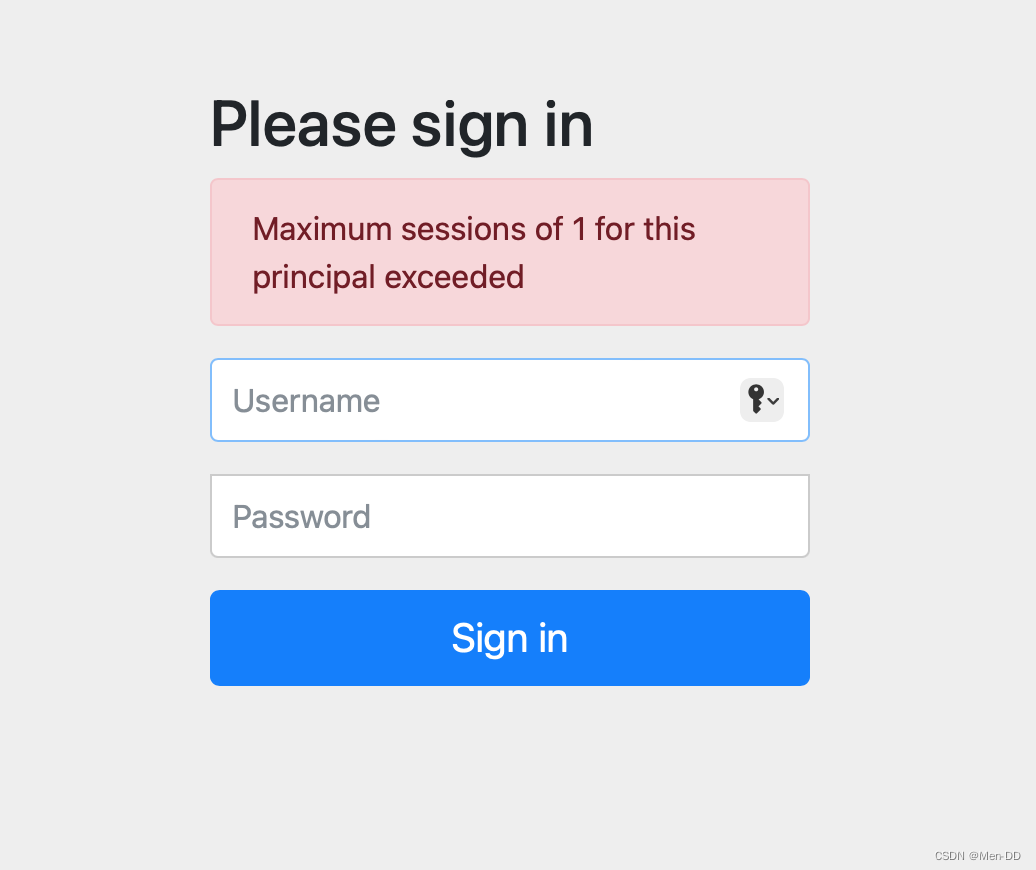
session 过期之后之前的无法登陆了, 正式不建议使用默认的需要自己实现

要想使用需要配置 maxSessionsPreventsLogin = false
http.sessionManagement().invalidSessionUrl("/session/invalid")
.maximumSessions(1)
.expiredSessionStrategy(new MySessionInformationExpiredStrategy())
.maxSessionsPreventsLogin(false);
集群session

<dependency>
<groupId>org.springframework.session</groupId>
<artifactId>spring-session-data-redis</artifactId>
</dependency>
<dependency>
<groupId>redis.clients</groupId>
<artifactId>jedis</artifactId>
<version>3.1.0</version>
</dependency>
spring:
session:
store-type: redis
redis:
host: redis.localhost.com
database: 5
password: pwd
SessionManagementFilter
SecurityContextPersistenceFilter
SessionRepositoryFilter#doFilterInternal
try {
filterChain.doFilter(wrappedRequest, wrappedResponse);
}
finally {
wrappedRequest.commitSession();
//SessionRepositoryFilter.this.sessionRepository.save(session);
}



SessionId 是写在cookie 里面的
缺点:
Spring Session + Redis实现分布式Session共享 有个非常大的缺陷, 无法实现跨域名共享session , 只能在单台服务器上共享session , 因为是依赖cookie做的 , cookie 无法跨域。 Spring Session一般是用于多台服务器负载均衡时共享Session的,都是同一个域名,不会跨域。
真正使用还是需要时 oauth2
安全会话cookie
我们可以使用httpOnly和secure标签来保护我们的会话cookie:
- httpOnly:如果为true,那么浏览器脚本将无法访问cookie
- secure:如果为true,则cookie将仅通过HTTPS连接发送
spring boot配置文件:
server:
servlet:
session:
timeout: 60s #default 30m
cookie:
http-only: true #httpOnly:如果为true,那么浏览器脚本将无法访问cookie
secure: true #如果为true,则cookie将仅通过HTTPS连接发送
RememberMe = RememberMeAuthenticationFilter
create table persistent_logins (
username varchar(64) not null,
series varchar(64) primary key,
token varchar(64) not null,
last_used timestamp not null
)
@Autowired
public DataSource dataSource;
public PersistentTokenRepository persistentTokenRepository(){
JdbcTokenRepositoryImpl jdbcTokenRepository = new JdbcTokenRepositoryImpl();
//设置数据源
jdbcTokenRepository.setDataSource(dataSource);
return jdbcTokenRepository;
}
@Override
protected void configure(HttpSecurity http) throws Exception {
//记住我
http.rememberMe()
.tokenRepository(persistentTokenRepository())//设置持久化仓库
.tokenValiditySeconds(3600) //超时时间,单位s 默认两周
.userDetailsService(userService); //设置自定义登录逻辑
}
<input type="checkbox" name="remember-me" value="true"/><br/>
退出登录 LogoutFilter
Spring security默认实现了logout退出,用户只需要向 Spring Security 项目中发送 /logout 退出请求即可。
自定义退出逻辑
http.logout()
.logoutUrl("/logout")
.logoutSuccessUrl("/login.html");
SecurityContextLogoutHandler
当退出操作出发时,将发生:
- 销毁HTTPSession 对象
- 清除认证状态
- 跳转到 /login.html
LogoutSuccessHandler
退出成功处理器,实现 LogoutSuccessHandler 接口 ,可以自定义退出成功处理逻辑。
CSRF CsrfFilter
CSRF(Cross-site request forgery)跨站请求伪造,也被称为“OneClick Attack” 或者 Session Riding。通过伪造用户请求访问受信任站点的非法请求访问。
跨域:只要网络协议,ip 地址,端口中任何一个不相同就是跨域请求。
客户端与服务进行交互时,由于 http 协议本身是无状态协议,所以引入了cookie进行记录客户端身份。在cookie中会存放session id用来识别客户端身份的。在跨域的情况下,session id 可能被第三方恶意劫持,通过这个 session id 向服务端发起请求时,服务端会认为这个请求是合法的,可能发生很多意想不到的事情。
防御CSRF攻击策略
- 验证 HTTP Referer 字段
- 在请求地址中添加 token 并验证
- 在 HTTP 头中自定义属性并验证
从 Spring Security4开始CSRF防护默认开启,默认会拦截请求,进行CSRF处理。CSRF为了保证不是其他第三方网站访问,要求访问时携带参数名为 _csrf 值为token(token 在服务端产生,在渲染请求页面时埋入页面)的内容,如果token和服务端的token匹配成功,则正常访问。
@Configuration
public class CSRFWebSecurityConfig extends WebSecurityConfigurerAdapter {
@Bean
public PasswordEncoder passwordEncoder() {
// return NoOpPasswordEncoder.getInstance();
return new BCryptPasswordEncoder();
}
@Override
protected void configure(AuthenticationManagerBuilder auth) throws Exception {
auth.inMemoryAuthentication()
.withUser("mendd")
.password(passwordEncoder().encode("123456"))
.authorities("admin");
}
@Override
protected void configure(HttpSecurity http) throws Exception {
http.formLogin()
.loginPage("/showLogin")
.loginProcessingUrl("/login")
.defaultSuccessUrl("/main.html");
http.authorizeRequests()
.antMatchers("/showLogin").permitAll()
.anyRequest().authenticated();
// http.csrf().disable();
}
}
@Controller
public class LoginController {
@RequestMapping("/showLogin")
public String showLogin() {
return "login";
}
}
<!DOCTYPE html>
<html xmlns="http://www.w3.org/1999/xhtml"
xmlns:th="http://www.thymeleaf.org">
<head>
<meta charset="UTF-8">
<title>Login</title>
</head>
<body>
<form action="/login" method="post">
<input type="hidden" th:value="${_csrf.token}" name="_csrf" th:if="${_csrf}"/>
用户名: <input type="text" name="username1"/><br/>
密码: <input type="password" name="password1"/><br/>
记住我: <input type="checkbox" name="remember-me" value="true"/><br/>
<input type="submit" value="提交"/>
</form>
</body>
</html>

修改配置类
http.csrf().disable(); //关闭csrf防护
原理
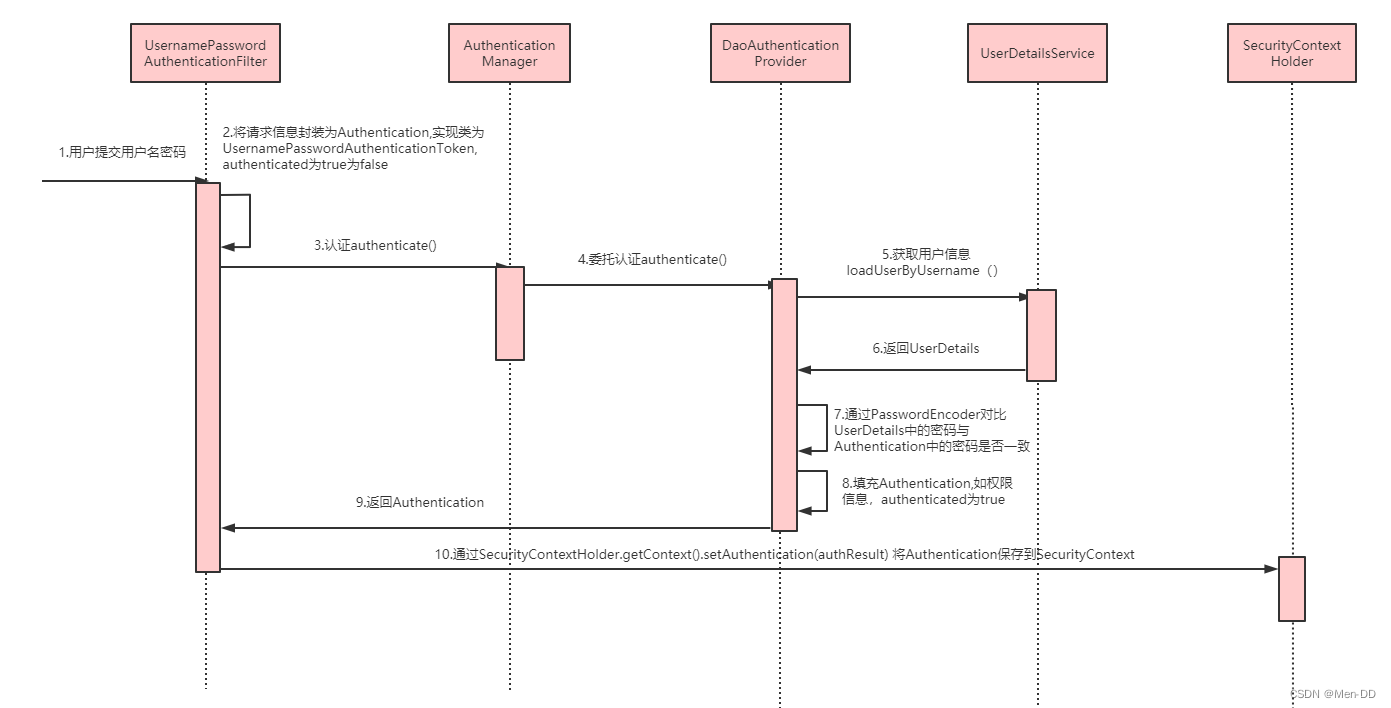
Spring Security是如何完成身份认证的?
- 用户名和密码被过滤器获取到,封装成Authentication,通常情况下是UsernamePasswordAuthenticationToken这个实现类
- AuthenticationManager 身份管理器负责验证这个Authentication
- 认证成功后,AuthenticationManager身份管理器返回一个被填充满了信息的(包括上面提到的权限信息,身份信息,细节信息,但密码通常会被移除)Authentication实例
- SecurityContextHolder安全上下文容器将第3步填充了信息的Authentication,通过SecurityContextHolder.getContext().setAuthentication(…)方法,设置到其中
相关接口
- AuthenticationManager 认证管理器,用于处理一个认证请求,提供了认证方法的入口
public interface AuthenticationManager {
Authentication authenticate(Authentication authentication) throws AuthenticationException;
}
-
ProviderManager是 AuthenticationManager 的一个实现类,提供了基本的认证逻辑和方法;它包含了一个List属性,通过 AuthenticationProvider 接口来扩展出多种认证方式,实际上这是委托者模式的应用(Delegate)
-
Authentication在spring security中是最高级别的身份/认证的抽象,由这个顶级接口,我们可以得到用户拥有的权限信息列表,密码,用户细节信息,用户身份信息,认证信息
-
UsernamePasswordAuthenticationToken实现了 Authentication主要是将用户输入的用户名和密码进行封装,并供给 AuthenticationManager 进行验证;验证完成以后将返回一个认证成功的 Authentication 对象
public interface Authentication extends Principal, Serializable {
//1.权限信息列表,可使用AuthorityUtils.commaSeparatedStringToAuthorityList("admin,ROLE_ADMIN")返回字符串权限集合
Collection<? extends GrantedAuthority> getAuthorities();
//2.密码信息,用户输入的密码字符串,在认证过后通常会被移除,用于保障安全。
Object getCredentials();
//3.认证时包含的一些信息,web应用中的实现接口通常为 WebAuthenticationDetails,它记录了访问者的ip地址和sessionId的值。
Object getDetails();
//4.身份信息,大部分情况下返回的是UserDetails接口的实现类
Object getPrincipal();
//5.是否被认证,认证为true
boolean isAuthenticated();
//6.设置是否能被认证
void setAuthenticated(boolean isAuthenticated) throws IllegalArgumentException;
}
-
SecurityContextHolder 用于存储安全上下文(security context)的信息,SecurityContextHolder默认使用ThreadLocal 策略来存储认证信息
SecurityContextHolder.getContext().getAuthentication() -
UserDetailsService
public interface UserDetailsService {
// 根据用户名加载用户信息
UserDetails loadUserByUsername(String username) throws UsernameNotFoundException;
}
-
UserDetails 用户信息核心接口,默认实现类org.springframework.security.core.userdetails.User
-
PasswordEncoder BCryptPasswordEncoder 是 Spring Security 官方推荐的密码解析器 。BCryptPasswordEncoder 是对 bcrypt 强散列方法的具体实现,是基于Hash算法实现的单向加密,可以通过strength控制加密强度,默认 10。
String passwd = BCrypt.hashpw("123",BCrypt.gensalt());
boolean checkpw = BCrypt.checkpw("123", passwd);
用户授权(访问控制)
- web授权: url拦截进行授权 FilterSecurityInterceptor
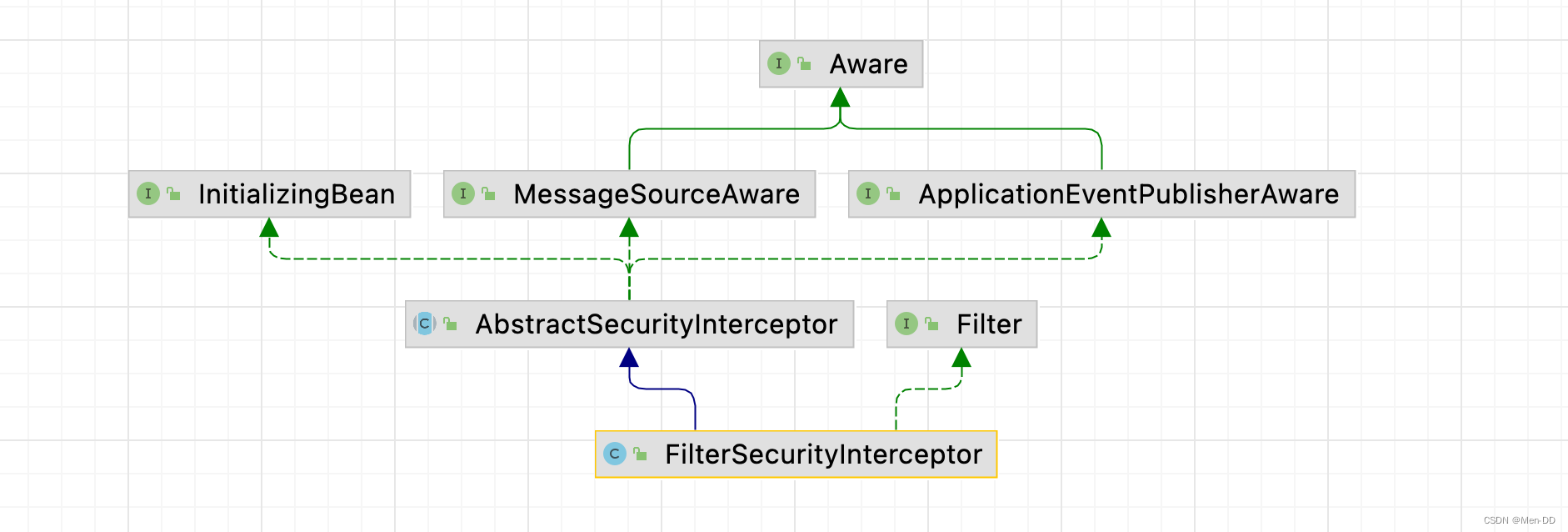
- 方法授权: 方法拦截进行授权 MethodSecurityInterceptor
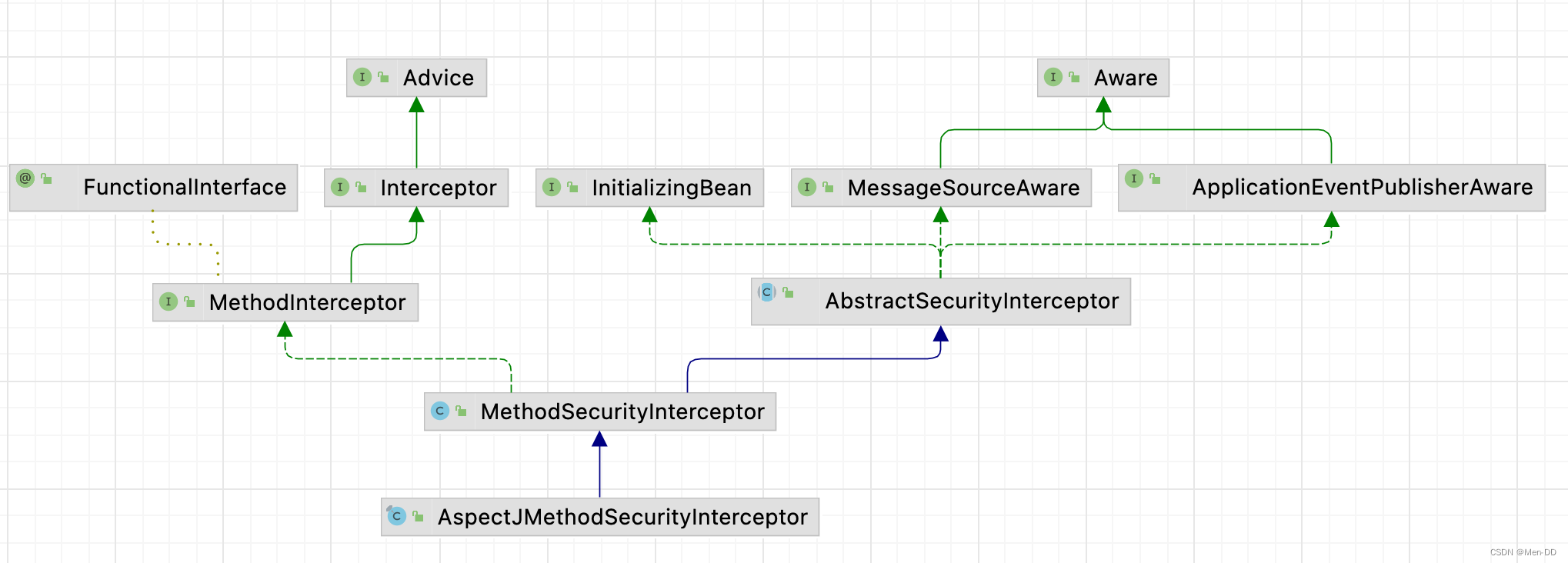
未登录匿名用户: anonymousUser AnonymousAuthenticationFilter
web授权: url拦截进行授权 FilterSecurityInterceptor
http.authorizeRequests()
//设置哪些路径可以直接访问,不需要认证
.antMatchers("/user/login","/login.html").permitAll()
.anyRequest().authenticated(); //需要认证才能访问
访问控制的url匹配
- anyRequest() 表示匹配所有的请求
.anyRequest().authenticated() - antMatchers(String… antPatterns)
.antMatchers("/js/**","/css/**").permitAll()
| 通配符 | 说明 |
|---|---|
| ? | 匹配任何单字符 |
| * | 匹配0或者任意数量的字符 |
| ** | 匹配0或者更多的目录 |
- regexMatchers() 使用正则表达式进行匹配
.regexMatchers( ".+[.]js").permitAll() - mvcMatchers() 适用于配置了 servletPath 的情况
spring.mvc.servlet.path=/web&.mvcMatchers("/admin/demo").servletPath("/web").permitAll()
RequestMatcher接口
| 实现类 | 介绍 |
|---|---|
AnyRequestMatcher |
匹配任何请求 |
AntPathRequestMatcher |
使用ant风格的路径匹配模板匹配请求 |
ELRequestMatcher |
使用EL表达式匹配请求 |
IpAddressMatcher |
基于IP地址匹配请求,支持IPv4和IPv6 |
MediaTypeRequestMatcher |
基于MediaType匹配请求 |
RegexRequestMatcher |
基于正则表达式匹配请求 |
RequestHeaderRequestMatcher |
基于头部值比较匹配请求 |
AndRequestMatcher |
and组合多个RequestMatcher |
OrRequestMatcher |
or组合多个RequestMatcher |
NegatedRequestMatcher |
not操作一个RequestMatcher |
MvcRequestMatcher |
使用Spring MVC的HandlerMappingIntrospector匹配请求 |
内置的访问控制
-
【常用】
#permitAll()方法,所有用户可访问。 -
【常用】
#denyAll()方法,所有用户不可访问。 -
【常用】
#authenticated()方法,登录用户可访问。 -
#anonymous()方法,无需登录,即匿名用户可访问。 -
#rememberMe()方法,通过 remember me登录的用户可访问。 -
#fullyAuthenticated()方法,非 remember me 登录的用户可访问。 -
#hasIpAddress(String ipaddressExpression)方法,来自指定 IP 表达式的用户可访问。 -
【常用】
#hasRole(String role)方法, 拥有指定角色的用户可访问,角色将被增加“ROLE_”前缀。 -
【常用】
#hasAnyRole(String... roles)方法,拥有指定任一角色的用户可访问。 -
【常用】
#hasAuthority(String authority)方法,拥有指定权限(authority)的用户可访问。 -
【常用】
#hasAuthority(String... authorities)方法,拥有指定任一权限(authority)的用户可访问。 -
【最牛】
#access(String attribute)方法,当 Spring EL 表达式的执行结果为true时,可以访问。
自定义403处理方案

使用 Spring Security 时经常会看见 403(无权限)。Spring Security 支持自定义权限受限处理,需要实现 AccessDeniedHandler接口
public class MyAccessDeniedHandler implements AccessDeniedHandler {
@Override
public void handle(HttpServletRequest request, HttpServletResponse response, AccessDeniedException accessDeniedException) throws IOException, ServletException {
response.setStatus(HttpServletResponse.SC_FORBIDDEN);
response.setHeader("Content-Type", "application/json;charset=utf-8");
PrintWriter out = response.getWriter();
out.write("{\"status\":\"error\",\"msg\":\"权限不足,请联系管理员!\"}");
out.flush();
out.close();
}
}
http.exceptionHandling().accessDeniedHandler(new MyAccessDeniedHandler());
{
status: "error",
msg: "权限不足,请联系管理员!",
}
基于表达式的访问控制
access 表达式根对象的基类是SecurityExpressionRoot,提供了一些在web和方法安全性中都可用的通用表达式。
https://docs.spring.io/spring-security/site/docs/5.2.7.RELEASE/reference/htmlsingle/#tech-intro-access-control
可以通过 access() 实现和之前学习的权限控制完成相同的功能。
.antMatchers("/user/login","/login.html").access("permitAll")
.antMatchers("/admin/demo").access("hasAuthority('System')")
自定义方法 ExceptionTranslationFilter
认证异常 AuthenticationException login
授权异常 AccessDeniedException 403 accessDeniedHandler.handle(request, response,(AccessDeniedException) exception);
判断登录用户是否具有访问当前 URL 的权限。
在 access 中通过bean的beanName.方法(参数)的形式进行调用:
.anyRequest().access("@mySecurityExpression.hasPermission(request,authentication)")
@Component
public class MySecurityExpression {
public boolean hasPermission(HttpServletRequest request, Authentication authentication) {
// 获取主体
Object obj = authentication.getPrincipal();
if (obj instanceof UserDetails){
UserDetails userDetails = (UserDetails) obj;
//
String name = request.getParameter("name");
//获取权限
Collection<? extends GrantedAuthority> authorities = userDetails.getAuthorities();
//判断name值是否在权限中
return authorities.contains(new SimpleGrantedAuthority(name));
}
return false;
}
}
方法授权: 方法拦截进行授权 MethodSecurityInterceptor
基于注解的访问控制: Spring Security在方法的权限控制上支持三种类型的注解
- JSR-250注解
- @Secured注解
- 支持表达式的注解
启用:@EnableGlobalMethodSecurity 默认没有启用
- Service 接口或方法上
- Controller或 Controller 的方法
JSR-250注解 角色
- @RolesAllowed 表示访问对应方法时所应该具有的角色
- @PermitAll 表示允许所有的角色进行访问,也就是说不进行权限控制
- @DenyAll 是和PermitAll相反的,表示无论什么角色都不能访问
只能定义在方法上
开启注解 @EnableGlobalMethodSecurity(jsr250Enabled = true)
@EnableGlobalMethodSecurity(jsr250Enabled = true)
public class SecurityConfig extends WebSecurityConfigurerAdapter {
@RolesAllowed({
"ROLE_USER", "ROLE_ADMIN"})
//@PermitAll
@GetMapping("/demo")
public String demo() {
return "spring security demo";
}
@Secured注解 角色
@Secured 是专门用于判断是否具有角色的,能写在方法或类上。参数要以 ROLE_开头。
开启注解 @EnableGlobalMethodSecurity(securedEnabled = true)
@EnableGlobalMethodSecurity(securedEnabled = true)
public class SecurityConfig extends WebSecurityConfigurerAdapter {
@Secured("ROLE_ADMIN")
@GetMapping("/demo")
public String demo() {
return "spring security demo";
}
支持表达式的注解 权限
Spring Security中定义了四个支持使用表达式的注解,分别是
- @PreAuthorize 方法调用前
- @PostAuthorize 方法调用后
- @PreFilter 集合类型的参数过滤
- @PostFilter 返回值进行过滤
@EnableGlobalMethodSecurity(prePostEnabled = true)
public class SecurityConfig extends WebSecurityConfigurerAdapter {
- 使用@PreAuthorize进行访问控制
//@PreAuthorize("hasRole('ROLE_ADMIN')")
//@PreAuthorize("hasRole('ROLE_USER') or hasRole('ROLE_ADMIN')")
//限制只能查询Id小于10的用户
@PreAuthorize("#id<10")
@RequestMapping("/findById")
public User findById(long id) {
User user = new User();
user.setId(id);
return user;
}
// 限制只能查询自己的信息
@PreAuthorize("principal.username.equals(#username)")
@RequestMapping("/findByName")
public User findByName(String username) {
User user = new User();
user.setUsername(username);
return user;
}
//限制只能新增用户名称为abc的用户
@PreAuthorize("#user.username.equals('abc')")
@RequestMapping("/add")
public User add(User user) {
return user;
}
- @PostAuthorize可以在方法调用完之后进行权限检查
// 在方法find()调用完成后进行权限检查,如果返回值的id是偶数则表示校验通过,否则表示校验失败,将抛出AccessDeniedException
@PostAuthorize("returnObject.id%2==0")
public User find(int id) {
User user = new User();
user.setId(id);
return user;
}
- 使用@PreFilter和@PostFilter进行过滤
使用@PreFilter和@PostFilter可以对集合类型的参数或返回值进行过滤。使用@PreFilter和@PostFilter时,Spring Security将移除使对应表达式的结果为false的元素。
@PostFilter("filterObject.id%2==0")
public List<User> findAll() {
List<User> userList = new ArrayList<User>();
User user;
for (int i=0; i<10; i++) {
user = new User();
user.setId(i);
userList.add(user);
}
return userList;
}
@PreFilter(filterTarget="ids", value="filterObject%2==0")
public void delete(List<Integer> ids, List<String> usernames) {
}
授权原理
重写 #configure(HttpSecurity http) 方法,主要配置 URL 的权限控制
调用 HttpSecurity#authorizeRequests() 方法,开始配置 URL 的权限控制。
@Override
protected void configure(HttpSecurity http) throws Exception {
http
// 配置请求地址的权限
.authorizeRequests()
.antMatchers("/test/echo").permitAll() // 所有用户可访问
.antMatchers("/test/admin").hasRole("ADMIN") // 需要 ADMIN 角色
.antMatchers("/test/normal").access("hasRole('ROLE_NORMAL')") // 需要 NORMAL 角色。
// 任何请求,访问的用户都需要经过认证
.anyRequest().authenticated()
.and()
// 设置 Form 表单登录
//自定义登录页面,可以通过 #loginPage(String loginPage) 设置
.formLogin()
//.loginPage("/login") // 登录 URL 地址
.permitAll() // 所有用户可访问
.and()
// 配置退出相关
.logout()
//.logoutUrl("/logout") // 退出 URL 地址
.permitAll(); // 所有用户可访问
}
@Configuration
@EnableGlobalMethodSecurity(prePostEnabled = true)
public class SecurityConfig extends WebSecurityConfigurerAdapter {
@RestController
@RequestMapping("/demo")
public class DemoController {
@PermitAll
@GetMapping("/echo")
public String demo() {
return "示例返回";
}
@GetMapping("/home")
public String home() {
return "我是首页";
}
@PreAuthorize("hasRole('ROLE_ADMIN')")
@GetMapping("/admin")
public String admin() {
return "我是管理员";
}
@PreAuthorize("hasRole('ROLE_NORMAL')")
@GetMapping("/normal")
public String normal() {
return "我是普通用户";
}
}
授权流程. 基于Filter

- 拦截请求,已认证用户访问受保护的web资源将被SecurityFilterChain中的 FilterSecurityInterceptor 的子 类拦截
- 获取资源访问策略,FilterSecurityInterceptor会从 SecurityMetadataSource 的子类 DefaultFilterInvocationSecurityMetadataSource 获取要访问当前资源所需要的权限Collection 。SecurityMetadataSource其实就是读取访问策略的抽象,而读取的内容,其实就是我们配置的访问规则
- 最后,FilterSecurityInterceptor会调用 AccessDecisionManager 进行授权决策,若决策通过,则允许访问资 源,否则将禁止访问
基于AOP MethodSecurityInterceptor#invoke
public Object invoke(MethodInvocation mi) throws Throwable {
InterceptorStatusToken token = super.beforeInvocation(mi);
Object result;
try {
result = mi.proceed();
}
finally {
super.finallyInvocation(token);
}
return super.afterInvocation(token, result);
}
相关接口
- AccessDecisionManager 采用投票的方式来确定是否能够访问受保护资源。 AccessDecisionManager中包含的一系列AccessDecisionVoter将会被用来对Authentication是否有权访问受保护对象进行投票,AccessDecisionManager根据投票结果,做出最终决策 。
Spring Security实现原理
核心配置 @EnableWebSecurity
https://www.processon.com/view/link/5fa53783637689653d8af2f7
@Retention(value = java.lang.annotation.RetentionPolicy.RUNTIME)
@Target(value = {
java.lang.annotation.ElementType.TYPE })
@Documented
@Import({
WebSecurityConfiguration.class,
SpringWebMvcImportSelector.class,
OAuth2ImportSelector.class })
@EnableGlobalAuthentication
@Configuration
public @interface EnableWebSecurity {
/**
* Controls debugging support for Spring Security. Default is false.
* @return if true, enables debug support with Spring Security
*/
boolean debug() default false;
}
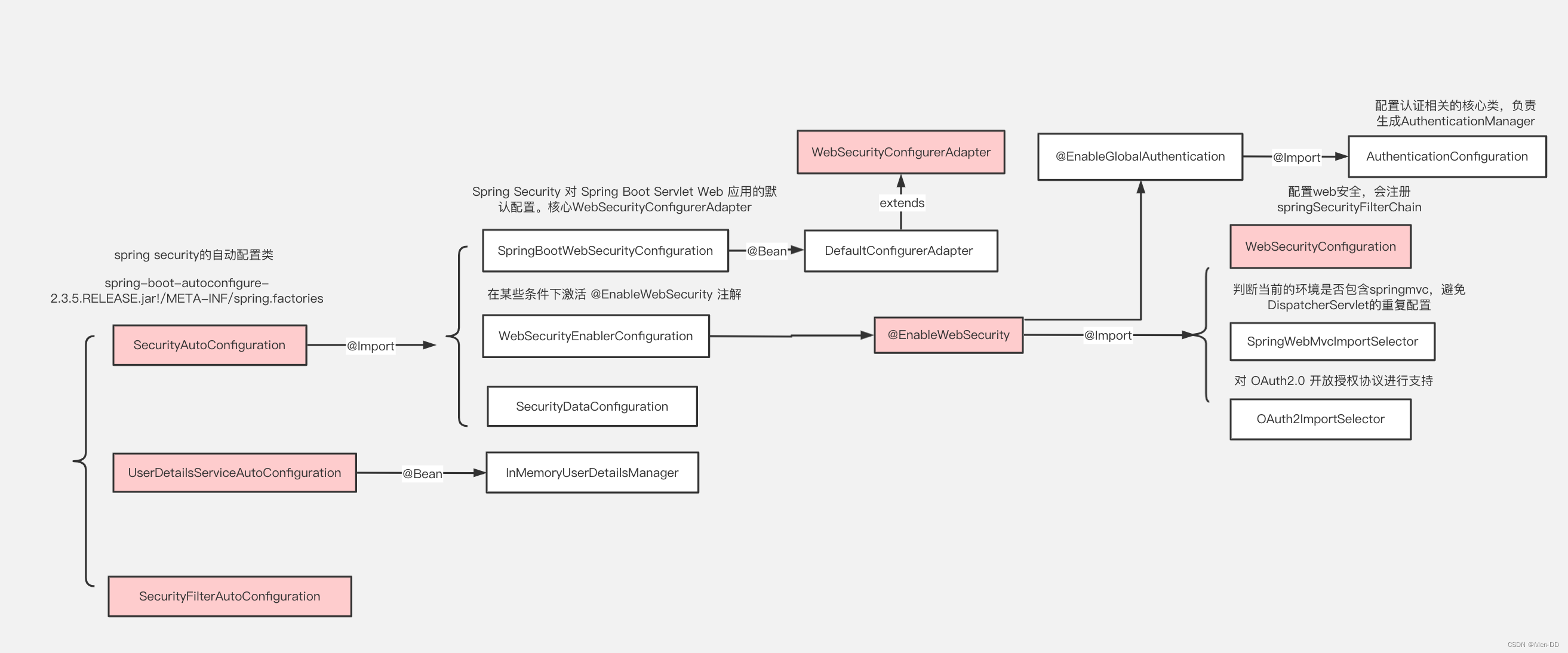
过滤器

SecurityFilterChain
- SecurityContextPersistenceFilter 两个主要职责:请求来临时,创建
SecurityContext安全上下文信息,请求结束时清空SecurityContextHolder。过滤器负责核心的处理流程,存储安全上下文和读取安全上下文的工作完全委托给了HttpSessionSecurityContextRepository去处理 - UsernamePasswordAuthenticationFilter 表单提交了username和password,被封装成token进行一系列的认证,便是主要通过这个过滤器完成的,在表单认证的方法中,这是最最关键的过滤器。
- ExceptionTranslationFilter 异常转换过滤器位于整个springSecurityFilterChain的后方,用来转换整个链路中出现的异常。此过滤器本身不处理异常,而是将认证过程中出现的异常交给内部维护的一些类去处理,一般处理两大类异常:AccessDeniedException访问异常和AuthenticationException认证异常。
- FilterSecurityInterceptor 从SecurityContextHolder中获取Authentication对象,然后比对用户拥有的权限和资源所需的权限。这是一个方法级的权限过滤器, 基本位于过滤链的最底部 。这个过滤器决定了访问特定路径应该具备的权限,访问的用户的角色,权限是什么?访问的路径需要什么样的角色和权限?这些判断和处理都是由该类进行的。
- HeaderWriterFilter 用来给http响应添加一些Header,比如X-Frame-Options, X-XSS-Protection*,X-Content-Type-Options
- CsrfFilter 在spring4中被默认开启的一个过滤器,用于防止csrf攻击(跨站点请求伪造(Cross-site request forgery))
- LogoutFilter 处理注销的过滤器
- RequestCacheAwareFilter 内部维护了一个RequestCache,用于缓存request请求
- SecurityContextHolderAwareRequestFilter :对ServletRequest进行了一次包装,使得request具有更加丰富的API
- SessionManagementFilter 和session相关的过滤器,内部维护了一个SessionAuthenticationStrategy,两者组合使用,常用来防止会话固定攻击保护(
session-fixation protection attack),以及限制同一用户开启多个会话的数量 - AnonymousAuthenticationFilter 匿名身份过滤器,spring security为了兼容未登录的访问,也走了一套认证流程,只不过是一个匿名的身份
链路
public abstract class AbstractSecurityWebApplicationInitializer
implements WebApplicationInitializer {
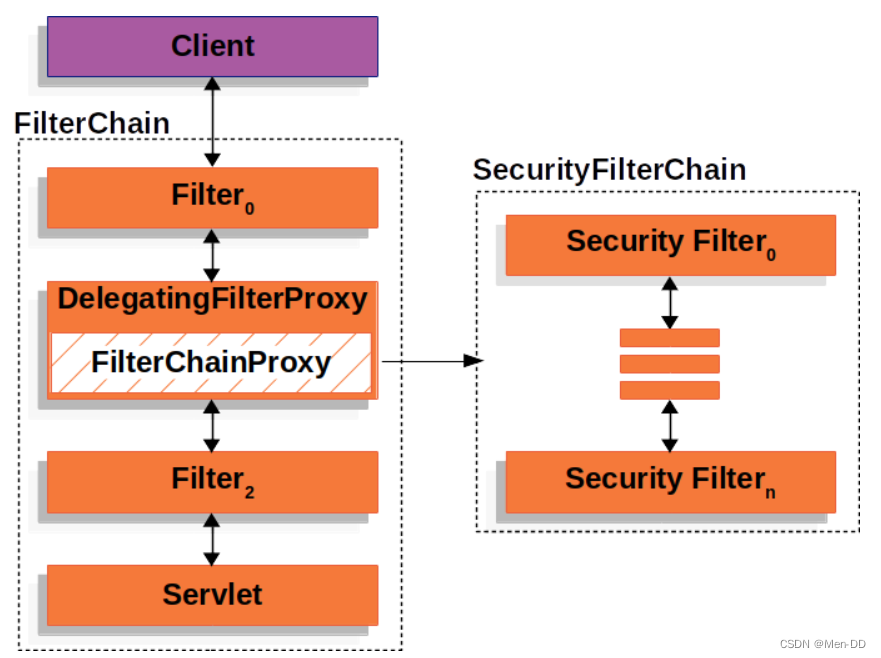
主线源码分析
https://www.processon.com/view/link/5fa3ae25e401fd45d10296e1
扩展知识 — Spring Authorization Server
扩展知识:
Spring官方已经不在维护Spring Security OAuth,官方单独启动一个授权服务器项目Spring Authorization Server
Spring Authorization Server 是 Spring 团队最新开发适配 OAuth 协议的授权服务器项目,旨在替代原有的 Spring Security OAuth Server
-
已支持授权码、客户端、刷新、注销等 OAuth 协议
-
SAS 项目已经迁移至官方正式仓库维护,成为官方的正式子项目
官方主页:https://spring.io/projects/spring-authorization-server -
Spring 团队正式宣布 Spring Security OAuth 停止维护,该项目将不会再进行任何的迭代;
-
作为 SpringBoot 3.0 的过渡版本 SpringBoot 2.7.0 过期了大量关于 SpringSecurity 的配置类,如沿用旧版本过期配置无法向上升级;
-
Spring团队原计划只提供 OAuth2 中的 Client 和 Resource Server功能。无奈广大人民强烈请求提供Authorization Server 功能,所以Spring团队便单独启动了一个项目做支持,名为Spring Authorization Server。官方说明:Announcing the Spring Authorization Server
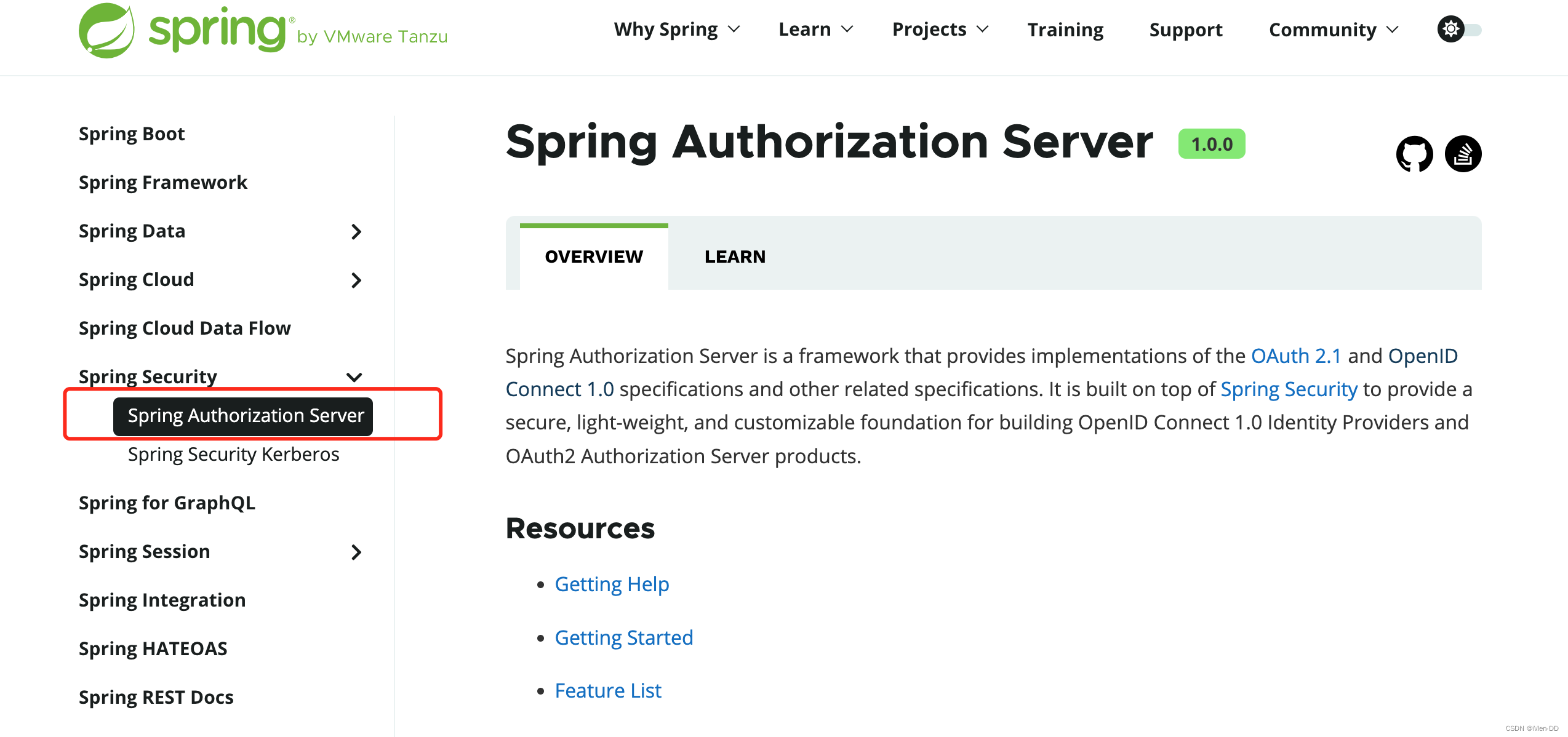
https://docs.spring.io/spring-authorization-server/docs/current/reference/html/getting-started.html#system-requirements